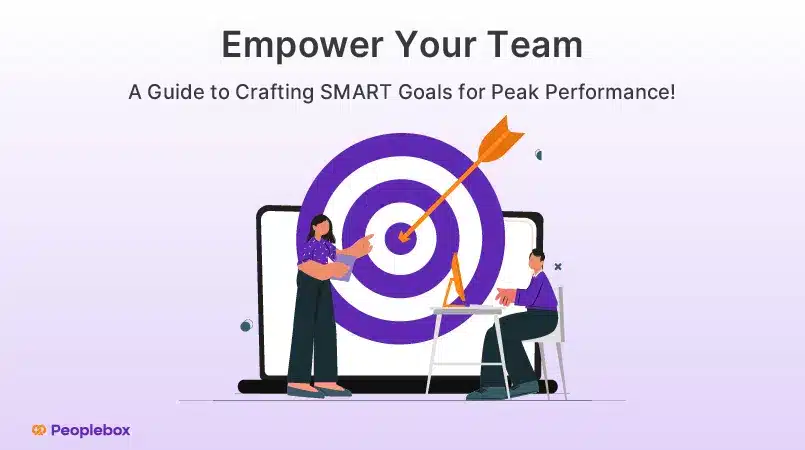Setting clear and measurable goals is the cornerstone of employee success. But, with so many factors at play, how do you craft goals that truly motivate your employees and empower them to be the best version of themselves?
That’s where many companies today use the SMART goals framework. In this blog post, we’ll provide practical SMART goals examples for work, demonstrating how to implement the SMART framework for various employee roles, fostering a culture of excellence and continuous improvement.
Chеck out our previous blog post if you are looking for Leadership SMART Goals Examples.

What Are SMART Goals?
SMART goals arе a structurеd approach to goal-sеtting, providing a roadmap for turning aspirations into tangiblе achiеvеmеnts. The acronym SMART stands for Spеcific, Mеasurablе, Achiеvablе, Rеlеvant, and Timе-bound. Each of these elements is crucial for ensuring that goals are well-defined, actionable, and aligned with the organization’s objectives.
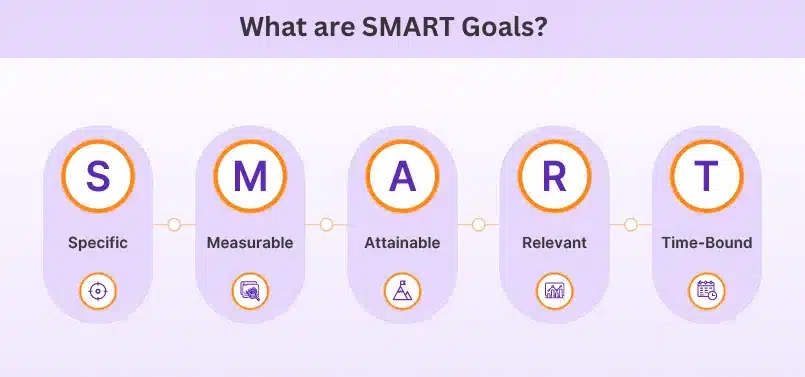
✅ Specific
The first element of SMART goals is Specificity. A specific goal clearly defines what needs to be accomplished and what the desired outcome should be. This element helps to avoid ambiguity and ensures that everyone involved understands what needs to be done.
For example, “Increase sales by 20% within the next 6 months” is a specific goal because it clearly states the target and the timeframe.
✅ Measurable
The second element of SMART goals is Measurability. A measurable goal includes quantifiable metrics to track progress and success. This element ensures that goals can be monitored and evaluated objectively.
For instance, “Increase sales revenue by $100,000 within the next 6 months” is a measurable goal because it includes a specific amount and a timeframe.
✅ Achievable
The third element of SMART goals is Achievability. An achievable goal must be realistic and within the capabilities of the individual or team. This element helps to avoid setting goals that are too ambitious or unrealistic.
For example, “Increase sales by 50% within the next 3 months” might be too ambitious and not achievable, whereas “Increase sales by 20% within the next 6 months” might be more realistic.
✅ Relevant
The fourth element of SMART goals is Relevance. A relevant goal must align with the organization’s strategic priorities and the individual’s role. This element ensures that goals are meaningful and contribute to the overall success of the organization.
For example, “Develop and implement a social media content strategy that increases the company’s LinkedIn followers by 500 within the next 3 months” is a relevant goal because it aligns with the company’s social media marketing strategy.
✅ Time-bound
The fifth and final element of SMART goals is Time-bound. A time-bound goal includes a clear deadline or timeline for achieving it. This element helps create a sense of urgency and ensures that goals are completed within a specific timeframe.
For example, “Refactor the legacy codebase to improve performance by 30% and reduce technical debt by the end of the current quarter” is a time-bound goal because it includes a specific deadline.
💪 What are the Benefits of SMART Goals for Work for Your Employees?
Implementing SMART goals within your organization offers a multitude of advantages for your employees. Here’s a closer look at how SMART goals empower your workforce:
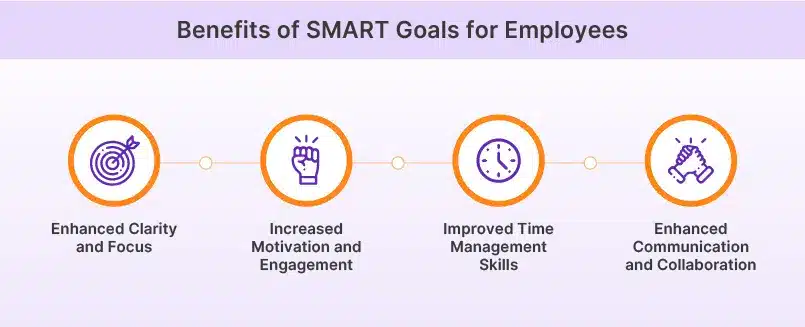
🧠 1. Enhanced Clarity and Focus: SMART goals provide a clear roadmap for what needs to be accomplished. Specific objectives eliminate ambiguity and allow employees to direct their efforts towards achieving tangible results.
🧩 2. Increased Motivation and Engagement: Measurable progress tracking inherent in SMART goals fosters a sense of achievement and motivation. Employees can see their contributions directly impacting the bigger picture, leading to increased engagement and job satisfaction.
⌛ 3. Improved Time Management Skills: Time-bound goals instill a sense of urgency and encourage employees to effectively manage their time. This fosters better organization and prioritization skills, leading to a more productive work environment.
🫂 4. Enhanced Communication and Collaboration: The process of establishing SMART goals often involves collaborative discussions between managers and employees. This fosters open communication and a shared understanding of expectations, leading to better teamwork and collaboration.
What are the Benefits of Setting Employee SMART Goals for the Business?
SMART goals aren’t just a win for employees. Here’s how a focus on SMART goals can help your organization:
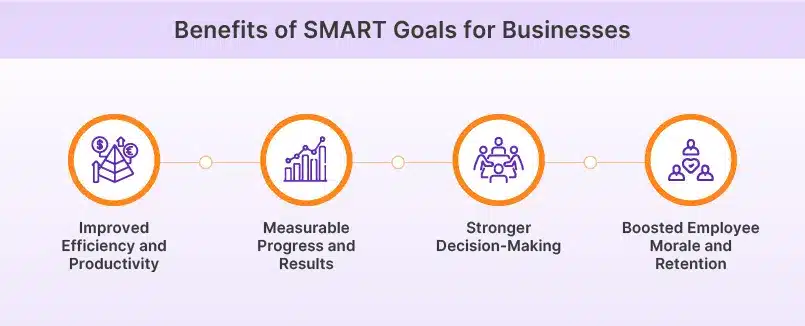
⚙️ 1. Improved Efficiency and Productivity: Clear and focused goals eliminate ambiguity and wasted efforts. Employees know exactly what’s expected and how their work contributes to the bigger picture, leading to increased efficiency and overall productivity gains.
⚖️ 2. Measurable Progress and Results: Measurable progress tracking within SMART goals allows you to monitor performance and identify areas for improvement. Data-driven insights enable you to make adjustments and optimize strategies to achieve desired outcomes.
🫡 3. Stronger Decision-Making: SMART goals provide a clear framework for decision-making. By aligning decisions with pre-defined goals, you can ensure your actions contribute directly to achieving desired results.
How to Set Employee SMART Goals for Work?
Setting SMART goals is a dynamic and iterative process that requires careful consideration and commitment. Here’s how you can set up SMART goals for employees in your organization.
1️⃣ Specificity: Clearly Define the Goal
👉 Focus on Outcomes: Move beyond vague statements like “improve customer service.” Instead, define a specific outcome such as “reduce customer churn rate by 5% within the next quarter.”
👉 Who, What, When, Where: Clearly identify who is responsible for achieving the goal, what specific actions need to be taken, and by when. Ensure the goal applies to the employee’s role and function.
2️⃣ Measurability: Establish Clear Metrics for Tracking Progress
👉 Quantify Whenever Possible: Use numbers and data points to define success. For example, instead of “improve sales,” aim for “increase sales of product X by 10% in the next sales cycle.”
👉 Identify Measurement Tools: Determine how progress will be tracked. This could involve sales reports, customer satisfaction surveys, or project management software.
3️⃣ Achievability: Set Goals that are Challenging Yet Attainable
👉 Balance Ambition with Realism: While goals should stretch employees and push them outside their comfort zone, they shouldn’t be completely out of reach. Unattainable goals can lead to discouragement and decreased motivation.
👉 Consider Resources and Skillsets: Factor in the employee’s current skills, experience, and available resources when setting the goal. Provide the necessary support and training to ensure achievability.
4️⃣ Relevance: Ensure Goals Align with Individual and Company Objectives
👉 Connect to Bigger Picture: Link employee goals to departmental and overall company objectives. This fosters a sense of purpose and demonstrates how individual contributions impact the broader success.
👉 Employee Input Matters: Involve employees in the goal-setting process. Consider their strengths, career aspirations, and areas for development when crafting goals.
5️⃣ Time-Bound: Set a Clear Deadline for Completion
👉 Establish a Realistic Timeline: Assign a specific timeframe for achieving the goal. This creates a sense of urgency and motivates timely action.
👉 Break Down Long-Term Goals: For long-term goals, consider setting smaller milestones with deadlines to maintain focus and track progress throughout the journey.
Next up, 35 employee SMART goals examples that you can implement immediately!
📈 Employee SMART Goals Examples for Performance Improvement
Performance improvement is crucial for any organization, and SMART goals offer a clear path to achieve this. Let’s explore seven employee smart goals examples, dissecting how they align with the SMART criteria:
💼 1. For a Sales Representative: ‘Increase monthly sales figures by 20% within the next quarter by expanding the client base and enhancing upselling techniques.’
📱 2. For a Customer Service Agent: ‘Reduce average call handling time by 15% over the next six months while maintaining a customer satisfaction score above 85%.’
📈 3. For a Marketing Manager: ‘Boost website traffic by 30% in the next four months through a targeted digital marketing campaign focusing on social media and SEO.’
🫂 4. For an HR Specialist: ‘Implement a new employee onboarding process by the end of Q3, aiming to increase new hire retention rates by 25%.’
🧑💼 5. For a Project Manager: ‘Complete the ongoing major project 10% under budget and two weeks ahead of the deadline without compromising on quality.’
🧑💻 6. For a Software Developer: ‘Enhance the software’s performance by reducing load time by 20% in the next three months through optimized code.’
🧑🎨 8. For a Graphic Designer: ‘Develop and launch a new branding package for the company within the next two months, aiming to increase brand recognition.’
ProTips
👉 Utilize existing performance metrics to set realistic and relevant goals.
👉 Analyze past performance data to identify areas needing improvement and set goals accordingly.
👉 Break down larger goals into smaller, manageable milestones. This helps maintain motivation and allows for easier tracking of progress.
⚙️ SMART Goal Setting Examples for Employees’ Skill Development
Skill development is key to career progression. Here are seven SMART goals focused on professional growth:
👨💼 1. For a Team Leader: ‘Attend a leadership training workshop by the end of Q2 to improve team management skills, aiming to increase team productivity by 15%.’
🧮 2. For an Accountant: ‘Complete an advanced certification in tax accounting within the next six months to provide more comprehensive services to clients.’
✍️ 3. For a Content Writer: ‘Publish at least two high-quality articles per week over the next quarter to refine writing skills and increase reader engagement.’
💻 4. For an IT Professional: ‘Obtain a cybersecurity certification by Q4 to enhance the company’s data security measures.’
💼 5. For a Sales Executive: ‘Participate in a weekly public speaking course for three months to improve presentation skills and client engagement.’
🫂 6. For an HR Coordinator: ‘Enroll in an online course on diversity and inclusion by next month, aiming to implement a new diversity policy by the year’s end.’
🖥️ 7. For a Digital Marketer: ‘Master a new social media analytics tool within the next two months to better measure campaign effectiveness and ROI.’
ProTips
👉 Conduct a skills assessment to determine precise areas where improvement is needed.
👉 Ensure that skill development goals support the employee’s career aspirations and growth within the organization.
👉 Ensure that goals include opportunities to apply new skills in real work scenarios, which reinforces learning and demonstrates proficiency.
💰 Employee SMART Goals Examples for Sales and Marketing
Sales and marketing are the engines of business growth. Here are seven employee SMART goals examples tailored for professionals across roles:
👨💼 1. For a Sales Manager: ‘Increase the team’s quarterly sales revenue by 25% by implementing a new customer relationship management system and refining sales strategies.’
✉️ 2. For a Marketing Coordinator: ‘Launch a new social media campaign within the next month, aiming to boost brand engagement by 30% and generate 500 new leads.’
🧑💻 3. For a Digital Marketer: ‘Improve website SEO to rank in the top 5 on Google search for key industry terms by the end of the year.’
💼 4. For a Sales Representative: ‘Expand the customer base in the new regional market by 20% within six months through targeted outreach and networking.’
📊 5. For a Marketing Analyst: ‘Conduct a comprehensive market analysis and present actionable insights to the team by the next quarter to inform future campaigns.’
🗣️ 6. For a Sales Consultant: ‘Develop and conduct three new sales training workshops by Q3 to enhance the team’s skills and improve conversion rates by 15%.’
🔊 7. For a Brand Manager: ‘Increase brand awareness by launching a cross-platform advertising campaign within four months, aiming for a 20% increase in social media followers.’
ProTips
👉 Define clear, numerical sales targets to provide a concrete objective for sales efforts.
👉 Ensure goals take into account the sales cycle and seasonality, providing realistic timeframes for achievement.
👉 Set goals that encourage collaboration between sales and marketing teams to ensure cohesive strategies.
🧑🤝🧑 Employee SMART Goal Examples for Team Building
Effective teamwork is vital for organizational success. Here are seven employee smart goals examples focused on enhancing team dynamics:
🧑🏻💼 1. For a Team Leader: ‘Organize monthly team-building activities throughout the year to improve collaboration and increase team satisfaction scores by 25%.’
🧕🏻 2. For a Project Manager: ‘Implement a bi-weekly check-in system for the next six months to enhance team communication and project efficiency.’
🫂 3. For an HR Manager: ‘Launch a mentorship program by Q2 to foster cross-departmental collaboration and employee development, aiming for a 30% increase in cross-functional projects.’
👩💼 4. For a Department Head: ‘Create and execute a quarterly team feedback and recognition system to boost morale and reduce turnover by 20% within the year.’
🧩 5. For a Team Coordinator: ‘Organize a series of skill-sharing workshops over the next three months to enhance team expertise and inter-departmental understanding.’
⚙️ 6. For an Operations Manager: ‘Develop a collaborative project management platform within four months to streamline workflow and improve team productivity by 15%.’
👨💼 7. For a Team Supervisor: ‘Facilitate a weekly problem-solving meeting for the next quarter to encourage innovative solutions and enhance team problem-solving skills.’
ProTips
👉 Use surveys and employee feedback tools to track team engagement levels and set improvement targets.
👉 Schedule consistent team meetings to discuss progress, address issues, and plan collaboratively.
👉 Recognize and celebrate team achievements to reinforce positive behaviors and teamwork.
🏆 Examples of SMART Goals for Employee Recognition
Recognizing and rewarding employees is key to maintaining high morale and motivation. Here are seven employee SMART goals examples focused on employee recognition:
🧑💼 1. For a Team Manager: ‘Implement a monthly employee recognition program by Q2, aiming to acknowledge at least two employees per department for their outstanding contributions.’
🫂 2. For an HR Officer: ‘Develop and launch an ‘Employee of the Month’ initiative by the end of the next month, aiming to increase overall employee engagement by 20%.’
🧑🤝🧑 3. For a Department Head: ‘Organize quarterly team awards ceremonies throughout the year to celebrate team achievements and individual excellence.’
👨💼 4. For a Company Executive: ‘Introduce a peer-to-peer recognition system by Q3, aiming to foster a positive work culture and increase employee satisfaction scores by 30%.’
🚶 5. For a Project Leader: ‘Create a digital ‘Kudos Board’ within two months where team members can publicly appreciate each other’s efforts, aiming to enhance team cohesion.’
⚙️ 6. For an Operations Manager: ‘Launch a bi-annual performance bonus scheme by the end of the year to reward top-performing employees, aiming to boost productivity by 15%.’
🧕🏻 7. For an Admin Supervisor: ‘Set up a ‘Wall of Fame’ in the office by next quarter to display employee achievements, aiming to create a culture of recognition and pride.’
ProTips
👉 Establish specific criteria for what constitutes recognition-worthy achievements.
👉 Promote a culture of peer-to-peer recognition to build a supportive work environment.
👉 Measure the impact of recognition programs on employee engagement and retention.
⏲️ Employee SMART Goal Examples for Time Management
Efficient time management is crucial for maximizing productivity. Here are seven SMART goals examples for work to improve time management skills:
🧑💼 1. For an Office Administrator: ‘Reduce meeting times by 20% within the next three months without compromising on decision-making quality to enhance overall office efficiency.’
🧑💻 2. For a Software Developer: ‘Implement a daily time tracking tool by next month to identify and reduce non-essential tasks, aiming to increase coding time by 25%.’
🔊 3. For a Marketing Specialist: ‘Plan and execute weekly schedules by every Monday for the next six months, aiming to improve project delivery times by 15%.’
💰 4. For a Sales Executive: ‘Allocate two hours each day for focused client interactions over the next quarter, aiming to reduce distractions and increase sales conversions by 20%.’
🫂 5. For an HR Coordinator: ‘Introduce a time management workshop for the HR team by Q2, aiming to streamline processes and reduce time spent on administrative tasks by 30%.’
💼 6. For a Project Manager: ‘Adopt a new project management software within two months to better allocate and track time on tasks, aiming to improve team productivity by 20%.’
☎️ 7. For a Customer Service Agent: ‘Implement a strategy to resolve customer queries within the first call 80% of the time over the next four months to reduce follow-up calls and enhance efficiency.’
ProTips
👉 Implement tools to track time spent on various tasks and analyze data for improvement.
👉 Develop a daily or weekly schedule with specific time blocks for different tasks.
👉 Set goals to reduce or eliminate common distractions in the workplace.
🥇 SMART Goal Examples for Leadership Development
Developing effective leaders is crucial for organizational success. Here are seven employee SMART goals examples focused on leadership and managerial growth:
💫 1. For an Aspiring Manager: ‘Complete a leadership training course within the next six months to enhance management skills, aiming to prepare for a team leader role.’
🧑🤝🧑 2. For a Team Supervisor: ‘Mentor two junior team members over the next quarter, focusing on their professional development and leadership skills, to foster future team leaders.’
🧕🏻 3. For a Department Head: ‘Initiate and lead a cross-departmental project by the end of the year, aiming to improve inter-departmental collaboration and leadership skills.’
👨💼 4. For a Senior Executive: ‘Host a monthly leadership workshop series for the next year, focusing on strategic thinking and decision-making skills for mid-level managers.’
💁🏻♀️ 5. For a HR Manager: ‘Develop a comprehensive leadership development program by Q3, targeting high-potential employees to prepare them for future leadership roles.’
👩🏿💼 6. For a Project Leader: ‘Enhance team leadership skills by successfully managing three diverse projects within the next six months, focusing on effective team coordination and goal achievement.’
📊 7. For a Business Analyst: ‘Lead a data-driven decision-making initiative by Q4, aiming to improve organizational strategies and demonstrate leadership in analytics.’
ProTips
👉 Determine specific leadership skills and competencies that need development.
👉 Use feedback from peers and mentors to improve leadership capabilities.
👉 Set goals to attend leadership training programs and apply learned skills.
🌎 SMART Goals Example for Remote Employees
Setting practical goals for remote employees is key to maintaining productivity and engagement. Here are seven employee SMART goals examples tailored for remote work:
💰 1. For a Remote Sales Representative: ‘Increase virtual client meetings by 30% over the next three months to enhance client engagement and boost sales in the remote environment.’
🔊 2. For a Remote Marketing Specialist: ‘Develop and execute a digital marketing campaign by the end of Q2, aiming to increase online traffic by 40%.’
👩 3. For a Remote Project Manager: ‘Complete a remote team project within four months, focusing on effective online collaboration and communication skills to meet all project milestones.’
🫂 4. For a Remote HR Coordinator: ‘Implement a virtual onboarding process for new hires by next month, aiming to streamline the remote hiring process and improve new hire satisfaction by 25%.’
🧑💻 5. For a Remote Developer: ‘Enhance coding efficiency by adopting new software development tools within the next two months, aiming to reduce bug rates by 20%.’
📱 6. For a Remote Customer Service Agent: ‘Achieve a 95% customer satisfaction rating in remote support interactions over the next quarter by enhancing soft skills and response time.’
✍️ 7. For a Remote Content Writer: ‘Produce and publish 12 high-quality blog posts per month for the next six months, focusing on timely and relevant topics to increase reader engagement.’
ProTips
👉 Establish specific guidelines for communication frequency and methods.
👉 Implement goals that foster team cohesion and collaboration remotely.
👉 Develop a detailed schedule to maintain work-life balance and productivity.
🎯 Why is OKR a Better Alternative to SMART Goals?
While SMART goals have long been a staple in performance management, Objectives and Key Results (OKRs) offer several advantages that make them a more effective approach for modern businesses. Here’s why you might consider making the switch:
1️⃣ Fosters Alignment and Transparency
OKRs emphasize ambitious, high-level objectives that connect directly to measurable results. This approach creates transparency across the organization, ensuring everyone understands the big picture and how their work contributes to achieving the company’s vision.
Unlike SMART goals, which can be focused on individual tasks, OKRs promote a sense of shared purpose and encourage teams to collaborate towards a common goal.
2️⃣ Encourages Continuous Improvement and Innovation
SMART goals are designed to be specific and achievable, which can sometimes lead to setting goals that are too safe and easily attainable. OKRs, on the other hand, push for ambitious objectives, even if reaching them entirely seems like a stretch.
This fosters a culture of continuous improvement and innovation, as teams are encouraged to think outside the box and develop creative solutions to achieve ambitious results.
3️⃣ Adaptability and Scalability
The business landscape is constantly evolving, and goals need to be adaptable to keep pace. OKRs offer greater flexibility than SMART goals. Objectives can be adjusted as circumstances change, and key results can be refined to ensure they accurately measure progress towards the overall goal.
This adaptability makes OKRs a better fit for companies that operate in dynamic environments.
4️⃣ Holistic Approach to Goal Setting
SMART goals typically focus on achieving specific, well-defined tasks. OKRs, however, take a more holistic approach by linking ambitious objectives with measurable results.

🥨 Unlocking Employee Potential with Peoplebox
Peoplebox’s OKR platform revolutionizes employee performance management by seamlessly integrating with your existing tools. Conducting employee reviews and tracking performance becomes not just accessible but highly effective with this comprehensive platform. From OKR tracking to performance reviews, Peoplebox covers every aspect of employee management.
Setting and monitoring goals is streamlined, aligning individual objectives with the company’s strategic vision.
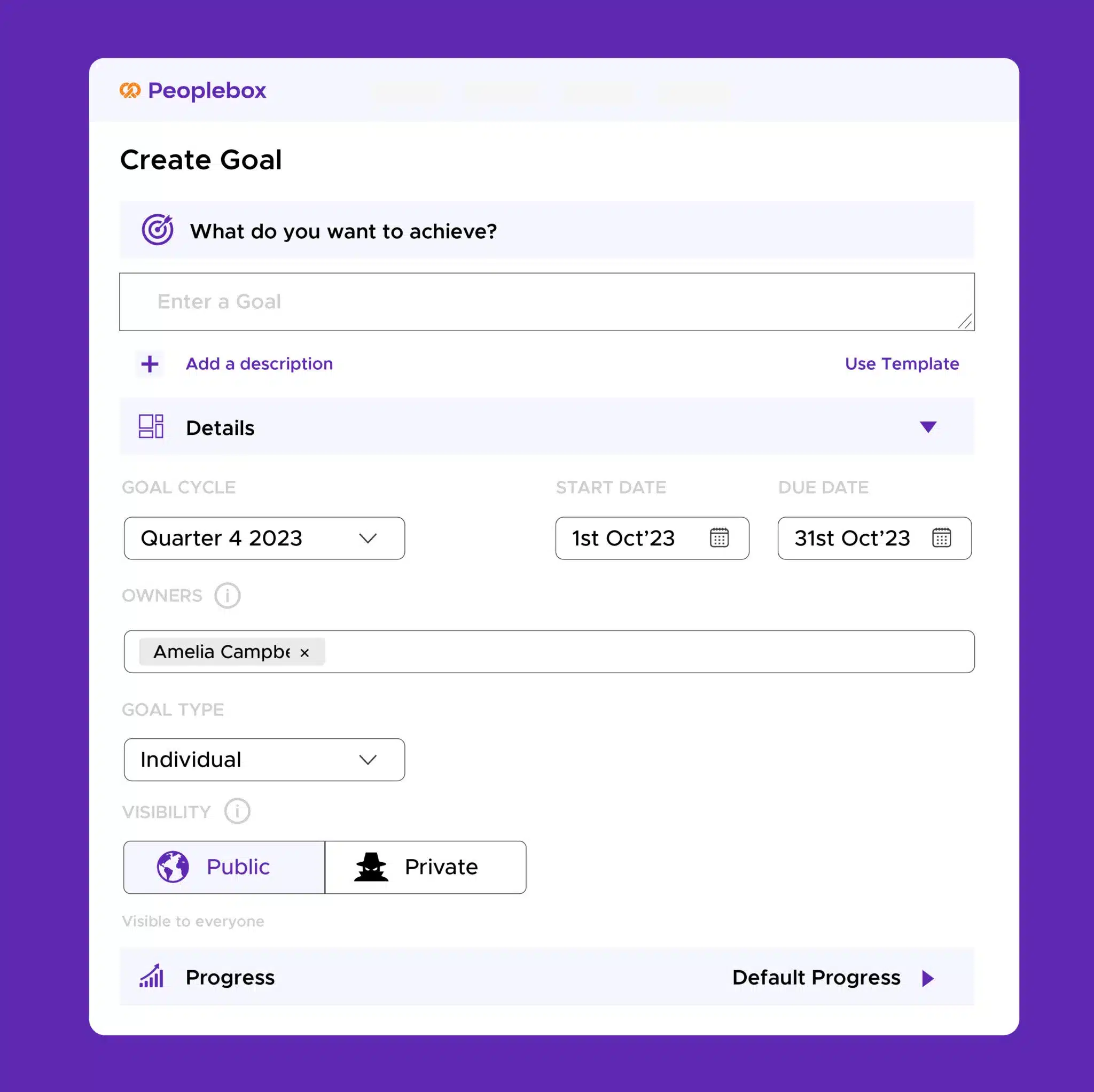
Deep integration with tools like Slack, Teams, and more provides real-time updates, making performance management continuous and engaging.
With Peoplebox, customization is at your fingertips, allowing you to tailor review processes to fit your unique needs. Whether setting up custom review cycles, connecting performance reviews with compensation decisions, or automating administrative tasks, Peoplebox offers impressive flexibility and efficiency, transforming how you manage employee performance.

Peoplebox is not just a tool; it’s a strategic partner in unlocking your team’s potential. By simplifying and enhancing the performance review process, it empowers HR professionals and leaders to focus on what truly matters – nurturing and developing talent.
Connect with us today to explore how you can elevate your organization’s performance management to the next level.

